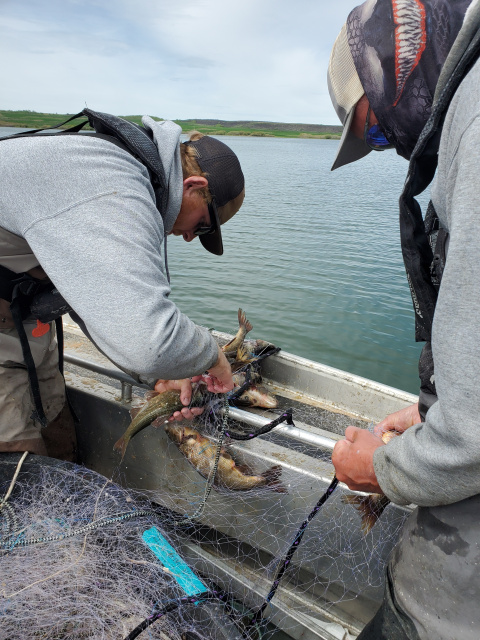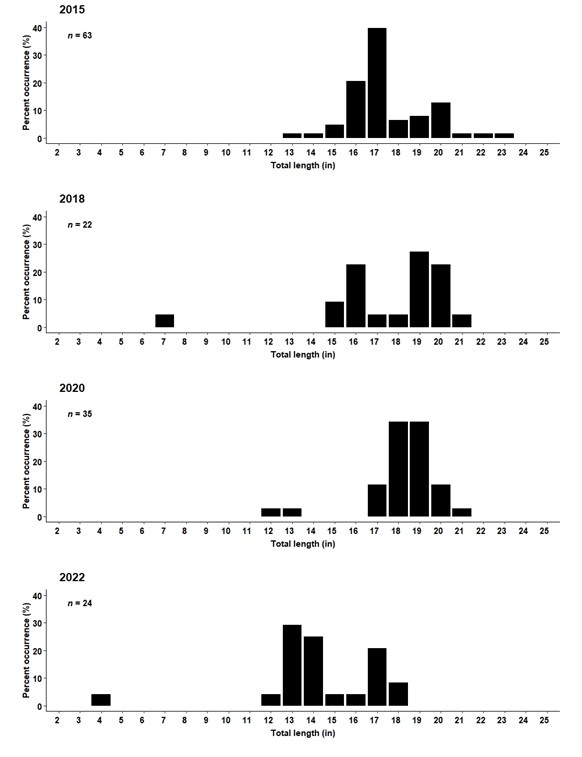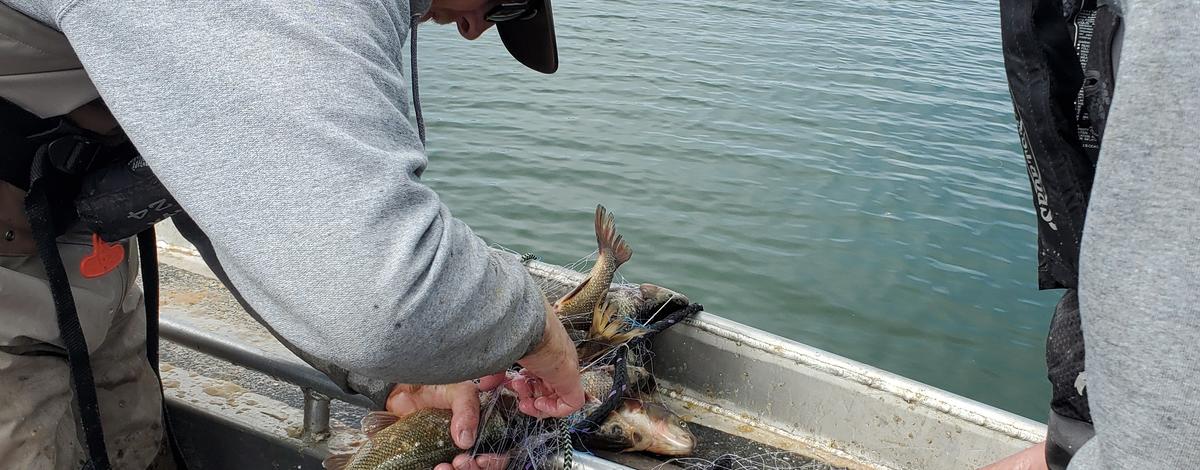Ever wonder how your favorite Idaho reservoir fishery is performing? Each year, Idaho Fish and Game regional fisheries biologists conduct surveys to help answer this question at many reservoirs across the state. The data collected helps us provide anglers with current fish population information and also informs our management actions by helping to evaluate if fishing regulations and stocking schedules are working as intended.
On reservoirs, biologists use a standardized suite of fish sampling gear (gill nets, trap nets, and night-time boat electrofishing) to ensure that the fish captured are a representative sample of the whole fishery. This standardized approach to sampling helps biologists compare data across years and different reservoirs to describe changes in reservoir fisheries.

Blackfoot Reservoir (located approximately 16 miles north of Soda Springs in southeast Idaho) was sampled in early June 2022 by the fisheries staff of Fish and Game’s Southeast Region. The standard suite of gear was deployed in randomly selected locations across the reservoir. The purpose of this survey was to evaluate the contribution of stocked rainbow trout to the fishery as well as to monitor the growth and distribution of the introduced smallmouth bass population.
A total of 24 rainbow trout were captured during the survey, with an average size of nearly 15 inches and an average weight of 1.4 pounds. The largest rainbow trout captured was 19 inches long and weighed 2.6 pounds. Based on the wear patterns on their fins, these individuals were classified as:
- likely stocked as a hatchery catchable (greater than 6 inches long when stocked)
- Or, a fingerling (less than 6 inches long when stocked)
Since catchables spend more time in the hatchery to grow to a larger size, they often have an arched dorsal fin while fingerlings spend a shorter time in the hatchery and usually have very little or no wear on their fins.
All rainbow trout stocked into Blackfoot Reservoir are sterile to avoid interbreeding with the native Yellowstone cutthroat trout, so we know there is no wild rainbow trout natural reproduction present in Blackfoot Reservoir. Most of the rainbow trout (88%) were classified as stocked as catchables while only 8% were classified as stocked as a fingerling, 4% were not classified. Because most rainbow trout in Blackfoot Reservoir appear to have been stocked as a catchable, biologists and hatchery staff are currently working together to find ways to provide more catchable rainbow trout to Blackfoot Reservoir to improve angler catch rates in the future.
Smallmouth bass were illegally introduced into Blackfoot Reservoir and first documented in surveys in 2015. Smallmouth bass are known predators of juvenile trout as well as capable of outcompeting trout for habitat and causing changes in trout diets by eating a trout’s preferred prey. Smallmouth bass are also able to thrive in river environments, leading to concerns that this illegal introduction could expand up into the Blackfoot River watershed and further threaten the recovering native Yellowstone cutthroat trout population.
Biologists have been monitoring the smallmouth bass in Blackfoot Reservoir to determine what level of threat they pose and whether management actions may be necessary. In 2022, 21 smallmouth bass were captured all in the boat electrofishing portion of the survey. This species was only found along rocky shorelines on the southern and eastern shores of the reservoir where the habitat is more suitable for bass. The average size of smallmouth bass captured was 9 inches and average weight was 0.6 pounds. The largest smallmouth bass sampled was 16.5 inches and weighed 2.6 pounds.
Fisheries staff are currently conducting a year-long creel survey on Blackfoot Reservoir to get a better understanding of angler catch rates and opinions about the fishery. Smallmouth bass were also tagged as part of this year’s survey to get an idea of angler catch rates and harvest of this species. Anglers who catch a tagged smallmouth should report it through the "Tag! You're it!" website or call the phone number printed on the tag. Remember that bass regulations on Blackfoot Reservoir changed in the last regulation cycle with no limit to harvest. Fisheries staff will continue to monitor the smallmouth bass population in Blackfoot Reservoir but for now, the population appears relatively small and localized to the rocky habitats.
Seven Yellowstone cutthroat trout were also captured in the survey. This low catch rate is likely due to the survey taking place during their spawning season when the majority of adult Yellowstone cutthroat trout leave the reservoir and migrate to the upper basin.


The trends observed in this survey appear very similar to past results. One notable difference was a decline in the average length of rainbow trout compared to the past three surveys. This result could be a product of a new cohort of catchable stocked rainbow trout becoming available to anglers. Another interesting trend is that Blackfoot Reservoir has been dominated by nongame species since sampling began in the 1960s. Past attempts were made to remove common carp and Utah suckers but in such a large reservoir, these efforts did not achieve much success.
This Blackfoot Reservoir survey will be repeated in 2025 to further investigate the trends of this fishery.

